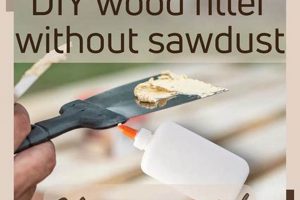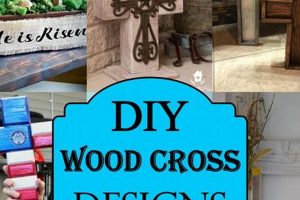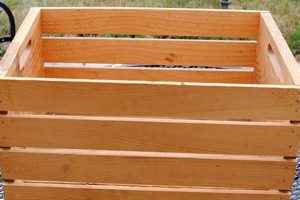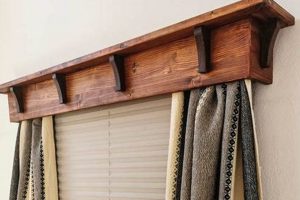The construction of custom containers for plants, utilizing wood as the primary material and involving individual effort in design and creation, represents a prevalent activity. This undertaking typically encompasses the selection of lumber, cutting and assembly of pieces, and often includes finishing treatments for weather resistance and aesthetic appeal. An example includes building a rectangular receptacle from cedar planks, fastened with screws, and lined with landscape fabric to house herbs on a patio.
Fabricating personalized plant holders allows for tailoring size and style to specific environmental conditions and design preferences. Such projects encourage resourcefulness, offering a cost-effective alternative to commercially produced items. Historically, self-made horticultural containers have provided accessible gardening solutions, particularly in urban environments where ground space is limited, promoting local food production and enhancing residential aesthetics.
The following sections will delve into material selection, construction techniques, design considerations, and maintenance practices relevant to building durable and attractive plant enclosures. These guidelines aim to equip individuals with the knowledge necessary to undertake successful horticultural container projects.
Construction Guidance for Horticultural Containers
The following guidance outlines essential considerations for achieving a structurally sound and aesthetically pleasing result. Adherence to these principles enhances the longevity and utility of the finished product.
Tip 1: Material Selection: Prioritize naturally rot-resistant wood species such as cedar, redwood, or cypress. Pressure-treated lumber is an alternative; however, ensure it is suitable for contact with soil and plants to avoid potential chemical leaching.
Tip 2: Design for Drainage: Incorporate drainage holes into the base of the structure to prevent waterlogging. A layer of gravel or landscape fabric at the bottom further facilitates proper drainage.
Tip 3: Precise Measurements and Cuts: Accuracy in cutting and assembly is crucial for structural integrity. Employ a measuring tape and saw with appropriate blades for clean, precise cuts.
Tip 4: Secure Fastening: Utilize corrosion-resistant screws or nails designed for outdoor use. Pre-drilling pilot holes prevents splitting of the wood during assembly.
Tip 5: Soil Compatibility: Line the interior with landscape fabric to prevent soil erosion and protect the wood from prolonged moisture exposure. Select a soil mix appropriate for the intended plant species.
Tip 6: Structural Reinforcement: For larger constructions, consider adding internal bracing or corner supports to enhance stability and prevent warping.
Tip 7: Protective Finishing: Apply a non-toxic, water-resistant sealant or stain to the exterior surfaces to protect against weather damage and prolong the lifespan of the wood.
Implementing these strategies will contribute to a finished product that is both functional and durable, capable of supporting healthy plant growth for an extended period.
The concluding section will provide insight into design variations and aesthetic customization options for these horticultural structures.
1. Wood Selection
The choice of wood fundamentally determines the lifespan and suitability of a self-made horticultural container. Wood selection directly influences the structure’s resistance to environmental factors, particularly moisture and decay. Inadequate wood selection can result in premature failure, negating the effort invested in construction. For instance, using untreated pine in a consistently damp environment will lead to rot within a year, whereas cedar or redwood, naturally resistant to decay, can last for several years under similar conditions. The appropriate selection serves as the foundation for a durable and functional plant holder.
The practical implications of wood selection extend beyond longevity. Certain woods can leach chemicals into the soil, affecting plant health. Treated lumber, while decay-resistant, often contains compounds harmful to edible plants. Consequently, untreated, naturally resistant varieties are often preferred for vegetable gardens or containers intended for food crops. Furthermore, the aesthetic properties of the wood impact the visual appeal of the completed structure. Cedar presents a reddish hue and a distinctive aroma, while redwood offers a darker tone. These visual differences allow for customized designs that complement their surroundings.
In summary, appropriate wood selection is paramount to the success of any plant container project. Overlooking this key element results in compromised structural integrity and potential harm to plant life. Careful consideration of wood species, accounting for environmental exposure, plant compatibility, and aesthetic preferences, ensures a functional and visually pleasing result, aligning with the objectives of self-made horticultural construction.
2. Drainage Design
Effective drainage design is a critical component of a successful wooden receptacle for plants. The primary function of drainage is to prevent waterlogging, a condition where the soil becomes saturated, depriving plant roots of oxygen. Without adequate drainage, root rot and fungal diseases are highly probable, leading to plant decline and eventual death. The absence of proper drainage design fundamentally undermines the functionality of the entire container. For instance, a well-constructed container, aesthetically pleasing but lacking drainage, will inevitably fail as a suitable environment for sustained plant growth.
The implementation of appropriate drainage solutions involves several key considerations. Firstly, the inclusion of drainage holes at the base of the structure is essential for excess water to escape. These holes should be appropriately sized and spaced to facilitate efficient water runoff without allowing soil to erode. Secondly, a layer of coarse material, such as gravel or crushed stone, placed at the bottom of the container, can enhance drainage by creating air pockets and preventing the compaction of soil around the drainage holes. Thirdly, the selection of a well-draining soil mix is crucial, as heavy clay soils can impede water flow, even with adequate drainage holes. A practical example involves comparing two identical receptacles, one with drainage holes and a gravel base filled with clay soil, and another with the same features but using a well-draining potting mix. The latter will demonstrably exhibit healthier plant growth due to improved root aeration.
In conclusion, drainage design is not merely an ancillary consideration but an integral aspect of plant containers. Its absence directly leads to detrimental consequences for plant health and the overall utility of the wooden structure. Proper drainage, achieved through a combination of drainage holes, coarse material layering, and appropriate soil selection, ensures a sustainable and thriving environment for plant life, thereby fulfilling the intended purpose of the self-made horticultural container. Understanding and implementing sound drainage principles are thus paramount for successful plant container construction.
3. Joint Strength
Joint strength, in the context of constructing wooden receptacles for plants, is paramount to the overall structural integrity and longevity of the finished product. The efficacy of the joints directly dictates the container’s ability to withstand the combined forces of soil weight, moisture exposure, and potential physical stresses. Weak joints lead to premature failure, manifesting as warping, separation, or complete collapse of the structure. Therefore, proper joint construction is not merely a matter of aesthetics but a critical determinant of the container’s functional lifespan. As an example, a container constructed with simple butt joints fastened solely with nails is likely to fail under the pressure of saturated soil, whereas a container using mortise-and-tenon or dovetail joints, even with less durable fasteners, will exhibit significantly greater resistance to deformation and breakage.
The practical application of understanding joint strength extends beyond the selection of appropriate joinery techniques. It also necessitates careful execution of those techniques, including precise cutting, proper alignment, and secure fastening. Different joint types offer varying levels of strength and complexity, and the choice should be guided by the intended size, weight, and environmental exposure of the container. For instance, a small herb may suffice with simple lap joints reinforced with screws, while a large tree requires the robust stability provided by interlocking joints and potentially internal bracing. The selection of fasteners also plays a crucial role; corrosion-resistant screws are generally preferred over nails, particularly in outdoor applications where moisture is prevalent. Furthermore, the application of appropriate adhesives, designed for exterior use, can significantly enhance joint strength and water resistance.
In summary, joint strength is an indispensable element of crafting durable receptacles for plants. The selection of appropriate joint types, coupled with meticulous construction techniques and the use of corrosion-resistant fasteners, ensures that the structure can withstand the rigors of its intended environment. Neglecting joint strength compromises the container’s structural integrity, leading to premature failure and negating the time and resources invested in its construction. A thorough understanding of joint mechanics, therefore, is essential for successful self-made container projects, ensuring both functionality and longevity.
4. Soil Compatibility
Soil compatibility represents a crucial determinant in the success of projects involving self-made wooden receptacles for plants. The type of soil directly affects plant health, influencing nutrient availability, drainage, and root development. Incompatible soil leads to stunted growth, nutrient deficiencies, and ultimately, plant failure, negating the purpose of the wooden container. For example, using heavy clay soil within a wooden structure without amending it can result in waterlogging, suffocating roots and fostering fungal diseases. Conversely, excessively sandy soil may drain too rapidly, depriving plants of essential moisture and nutrients.
The selection of appropriate soil must align with the specific needs of the plants intended for cultivation. Acid-loving plants, such as azaleas or blueberries, require an acidic soil mix with a low pH. Vegetables and herbs generally thrive in a well-drained, nutrient-rich loam. Succulents and cacti necessitate a fast-draining soil blend to prevent root rot. Neglecting these specific requirements diminishes plant vigor and yields. A practical demonstration would involve cultivating the same plant species in two identical containers, one filled with compatible soil and the other with incompatible soil. The disparity in plant health and growth would clearly illustrate the significance of appropriate soil selection. Further, the wooden construction itself can influence soil conditions over time. The wood may leach certain compounds into the soil or alter moisture retention, necessitating adjustments to the soil composition.
In summary, soil compatibility is inextricably linked to the success of using a wooden structure for gardening purposes. Selecting the proper soil type, tailored to the specific needs of the plants, ensures optimal growth and health. Ignoring this crucial aspect diminishes the value and purpose of the container. Therefore, a thorough understanding of plant-specific soil requirements is essential for anyone undertaking these projects, ensuring that the self-made construction serves as a suitable and thriving environment for plant life. Prioritizing soil quality and its suitability for the chosen plants mitigates potential complications and promotes a flourishing garden within the wooden framework.
5. Water Resistance
Water resistance is a critical attribute for any wooden receptacle intended for horticultural use. The persistent contact with moisture, both from irrigation and environmental exposure, creates an environment conducive to wood decay. Absent adequate protection, the structural integrity of the wooden construction is compromised, leading to warping, rot, and ultimately, failure of the container. The direct correlation between water exposure and wood degradation underscores the necessity of implementing effective water-resistant measures during the fabrication and maintenance of self-made plant enclosures. For instance, a container constructed from untreated pine and consistently subjected to wet conditions will exhibit signs of decay within a relatively short period, rendering it unusable. Conversely, a similar container treated with a water-resistant sealant can withstand prolonged exposure without significant degradation.
Achieving water resistance involves several strategies, including material selection, protective coatings, and design considerations. Choosing naturally rot-resistant wood species, such as cedar or redwood, provides inherent protection against moisture damage. However, even these woods benefit from additional treatment. Applying water-resistant sealants or paints to all exposed surfaces creates a barrier that prevents water from penetrating the wood fibers. The selection of the sealant is crucial, as it should be non-toxic to avoid leaching harmful chemicals into the soil. Furthermore, design elements such as elevated bases or drainage systems minimize direct contact with standing water, reducing the risk of moisture absorption. Regular maintenance, including periodic reapplication of protective coatings, is essential to preserve water resistance over time. A practical illustration involves comparing two identical plant holders, one regularly treated with sealant and the other left untreated. The former will maintain its structural integrity and aesthetic appeal for a significantly longer duration.
In summary, water resistance is an indispensable aspect of constructing enduring wooden containers for plants. Its implementation through careful material selection, the application of protective coatings, and thoughtful design ensures the longevity and functionality of the finished product. Neglecting water resistance invariably leads to premature decay and structural failure, negating the effort and resources invested in the container’s creation. A comprehensive approach to water resistance, therefore, is paramount for the success of self-made horticultural projects, ensuring that the wooden construction serves as a sustainable and thriving environment for plant life. It is therefore crucial to address water resistance and apply appropriate method to increase lifetime of wooden planter box diy
6. Structural Integrity
The ability of a wooden container to withstand applied forces and maintain its intended shape and function is paramount. In the context of self-made plant holders, structural integrity directly impacts longevity and suitability for supporting plant life. Soil weight, moisture exposure, and external physical stresses exert continuous pressure on the container’s structure. Insufficient structural integrity results in deformation, cracking, and eventual collapse, rendering the container unusable. The absence of a structurally sound foundation negates the benefits of proper soil selection, drainage, and other horticultural considerations. As an example, a poorly constructed structure may buckle under the weight of saturated soil, damaging plant roots and impeding growth, irrespective of the quality of the soil mix.
Achieving adequate structural integrity in a wooden plant holder necessitates careful attention to several factors. The selection of appropriate wood species, known for their strength and resistance to decay, forms the foundation. Employing robust joinery techniques, such as dovetail or mortise-and-tenon joints, strengthens the connections between individual components. Reinforcing corners and edges with metal brackets or internal bracing distributes stress and prevents warping. Furthermore, the use of corrosion-resistant fasteners, like stainless steel screws, ensures that joints remain secure over time, even in moist environments. A practical application of these principles involves comparing two containers, one built with weak joints and thin wood, and another constructed with reinforced joints and thicker wood. The latter demonstrably withstands greater stress and maintains its shape for a longer duration.
In summary, structural integrity constitutes an indispensable element in the successful construction and utilization of plant containers. It ensures the container’s ability to support plant life and withstand environmental stressors. Neglecting structural considerations compromises the container’s longevity and functionality, leading to premature failure and negating the effort invested in its creation. Prioritizing robust construction techniques and appropriate material selection is thus essential for anyone undertaking self-made container projects, ensuring both horticultural success and a lasting, aesthetically pleasing addition to the gardening environment.
7. Aesthetic Considerations
The visual appeal of a self-made wooden receptacle significantly impacts its integration into a surrounding environment. While structural integrity and horticultural functionality are paramount, the aesthetic qualities determine its compatibility with existing design elements and its contribution to overall visual harmony. Neglecting aesthetic elements results in a container that, despite its utility, appears discordant or detracts from the desired ambiance. For example, a crudely constructed, unfinished wooden box might effectively hold plants but detract from the aesthetic quality of a well-manicured garden or a sophisticated patio setting.
Aesthetic considerations encompass several key aspects. The type of wood, its finish, the shape and size of the container, and any decorative elements all contribute to its visual character. Cedar, with its reddish hue and aromatic qualities, provides a different aesthetic than the gray weathered appearance of reclaimed wood. Similarly, a sleek, modern design contrasts sharply with a rustic, distressed finish. The size and shape must be proportional to the plants they will house and the space they will occupy. Furthermore, decorative additions, such as paint, stencils, or carvings, allow for personalization and the incorporation of specific design themes. The selection of these elements should align with the style of the surrounding environment, whether it is a formal garden, a casual backyard, or an urban balcony.
In summary, while not strictly essential for plant growth, aesthetic considerations are integral to the successful integration of self-made containers into any environment. A thoughtfully designed and well-executed container enhances the visual appeal of its surroundings, creating a cohesive and harmonious space. Prioritizing aesthetics alongside functionality ensures that these projects serve both practical and decorative purposes, adding value to the overall environment. The impact of aesthetics on user perception and enjoyment makes it an indispensable component of successful container construction.
Frequently Asked Questions
The following represents a compilation of frequently encountered inquiries regarding the construction and maintenance of wooden plant containers. These responses aim to provide clarity and guidance for individuals undertaking such projects.
Question 1: What type of wood is most suitable for constructing a long-lasting plant container?
Naturally rot-resistant wood species, such as cedar, redwood, and cypress, are generally recommended. These varieties exhibit inherent resistance to moisture damage and decay, extending the lifespan of the container.
Question 2: Is pressure-treated lumber safe for use in plant holders intended for edible crops?
Traditional pressure-treated lumber contains chemicals that may leach into the soil and potentially contaminate edible plants. It is advisable to use untreated, naturally rot-resistant wood or to line the container with a barrier to prevent contact between the soil and treated wood.
Question 3: How can drainage be effectively incorporated into a wooden plant receptacle?
Drilling drainage holes in the base of the container is essential. Additionally, a layer of gravel or crushed stone at the bottom facilitates water runoff and prevents soil compaction around the drainage holes. Employing a well-draining soil mix further enhances drainage effectiveness.
Question 4: What type of fasteners should be used to assemble a wooden plant holder for outdoor use?
Corrosion-resistant fasteners, such as stainless steel or coated deck screws, are recommended. These fasteners resist rust and degradation caused by moisture exposure, ensuring the structural integrity of the container over time.
Question 5: How can the interior of a wooden container be protected from soil and moisture?
Lining the interior with landscape fabric or plastic sheeting prevents direct contact between the soil and the wood, minimizing moisture absorption and extending the life of the container. Ensure the lining does not impede drainage.
Question 6: What steps can be taken to prolong the lifespan of a wooden plant container?
Regularly applying a water-resistant sealant or stain to the exterior surfaces protects the wood from weather damage. Additionally, elevating the container off the ground prevents direct contact with moisture and reduces the risk of rot. Periodic inspection and repair of any damage, such as cracks or loose joints, further contribute to longevity.
The information provided addresses common concerns and misconceptions regarding the construction of wooden plant containers. Adherence to these recommendations promotes the creation of durable and functional horticultural structures.
The following section will provide insights into design variations and aesthetic personalization options for plant containers.
Concluding Remarks
The preceding discussion has explored the intricacies of crafting plant receptacles from wood, emphasizing critical factors from material selection to structural reinforcement. The successful undertaking of such projects hinges on a comprehensive understanding of these principles, translating into enduring and horticulturally sound structures. A disregard for any single element, be it drainage, joint strength, or wood type, diminishes the overall outcome and undermines the intended purpose.
Therefore, prospective builders should approach “wooden planter box diy” with diligent planning and meticulous execution. The knowledge presented serves as a foundation for creating functional and aesthetically pleasing horticultural features, contributing to both environmental enhancement and personal satisfaction. Future endeavors in this domain should prioritize sustainable practices and innovative design to further optimize the benefits derived from these self-made garden components.







